 Carl Purpus, Plant
Collector in Western America
Carl Purpus, Plant
Collector in Western America 
Barbara Ertter
University and Jepson
Herbaria
University of California
Berkeley, CA 94720






Topics in this Article: Literature Cited | REPRINTED FROM
… The Plant Biology of Eastern University of California
|
| Carl Albert Purpus was a pioneer plant collector in southeastern California whose chronicles and collections are of historical interest. His collecting trips in this area began in 1895 near Mt. Whitney. The following year he left his winter home near Springville and travelled up the Middle Tule River to the headwaters of the Little Kern River and down Cottonwood Creek into Owens Valley, returning by much the same route. In 1897 he collected first in the Piute Range of Kern County before crossing Walker Pass enroute to the Argus Range, after which he collected at the headwaters of the Kaweah River. In 1898, a drought year, he crossed Walker Pass again and proceeded north through the Argus Range and Owens Valley to Westgard Pass. He spent the rest of the summer in Nevada and Utah before returning through Fish Lake Valley and Sonora Pass. During these trips he collected the types of over 30 new taxa from southeastern California.
| Literature Cited: One of the most significant but
least known of the early collectors in the
southern Sierra Nevada and desert ranges to the east was Carl Albert Purpus, a
German born botanist who first came to the United States as a collector of
winter-hardy plants for the Darmstadt Botanical Garden, where his brother Joseph
Anton Purpus was head gardener. During the years 1895-1898, he collected nearly
2000 numbers, including the types of over 30 taxa, from the southern Sierra
Nevada, adjacent mountain ranges, and the Owens Valley. He became a "freelance"
collector, depending for income on sales of seeds, cacti, pinecones, and anything
else the German market would pay for. Sets of his herbarium collections were
also available for sale, resulting in the wide distribution of his specimens.
In addition, he wrote numerous articles on natural history that were published
in popular and technical German magazines, covering topics as diverse as
rattlesnakes [Purpus, 1896c] and redwoods [Purpus, 1896a].
|
| Literature Cited: Although Purpus's later years in
Mexico and that itinerary have been studied
and published elsewhere [Sousa, 1969], his United States travels have been
relatively unknown. This is the first in a series of presentations to fill the
gap. Most of the following information is derived from my translations of a
series of articles describing his journeys from 1895-1899 [Anonymous, 1896;
Purpus, 1896b, 1897, 1898, 1899], mostly published by the German Dendrological
Society, and from his field notes and letters to Katharine Brandegee (archives
of the University Herbarium, University of California, Berkeley).
|
|  South entrance to Potter Valley, California, May 1988.
South entrance to Potter Valley, California, May 1988.
Locations: Daunt. Potter Valley. Springville. Letters: 12/4/1896
Purpus apparently first moved to California in 1894, where he probably
stayed initially with his cousin Nettie in Potter Valley, Mendocino County. He
soon acquired a winter residence in Daunt, on the outskirts of Springville,
Tulare County. During this period he made contact with Katharine and Townshend
Brandegee, with whom he maintained a close interaction. He sent them the first
set of his collections, refusing to accept payment even though he depended on the
sale of specimens for his livelihood. Townshend described most of the new
species he collected, including the genus Purpusia in the Rosaceae, while
Katharine was apparently a partner in his cactus-selling venture.
|
|  Foxtail pine on Tawny Point, Bighorn Plateau, California.
Foxtail pine on Tawny Point, Bighorn Plateau, California.
Locations: Mount Whitney. Purpus's first summer
in the Sierra Nevada was 1895, spent in the area
around Mt. Whitney. The article [Anonymous, 1896] describing the area to his
German audience is full of the superlatives that characterize Purpus's writing:
|
| Other Articles: Purpus' Introductions: 0130
| One feels overwhelmed, as if placed in another world, when viewing these gray-white giants. . . . All these toothlike peaks drop precipitously to the east in every sense of the word, the easternmost more than 3400 meters straight down into the Owens River Valley. The view from this precipice is truly terrifying.
|  Carl A. Purpus, with a Sequoia and a dog.
Carl A. Purpus, with a Sequoia and a dog.
Other Articles: Purpus' Introductions: 0160
| The sight of the giant trees of Sequoia gigantea is truly awesome. One feels completely overwhelmed, in another world, when seeing these monuments to ages long past for the first time.
|  Abronia alpina.
Abronia alpina. Other Articles: Purpus' Introductions: 0280 | In granitic gravel below the volcano, I encountered a low mat-forming Allionia unknown to me, which was completely covered with rose-red flowers, providing a lovely sight beyond all description.
| This last was in
reference to a new species he collected on this trip, Abronia alpina Brandeg.
| |
[Next Page] | |
| [Published Biographies] [Travelogues and Articles] [Letters] [Plant Lists and Bibliography] [Site Administration] | | Date and time this article was prepared: 6/7/2002 7:32:32 PM |